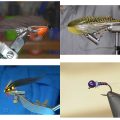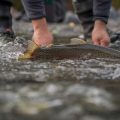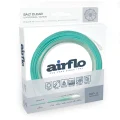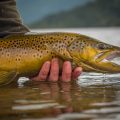How to Tie the Balanced Leech – Bruised
Producer: tightlinevideo
My good buddy Phil Rowley, and Colin McKeown from The New Fly Fisher really got me going on this Balanced Leech in a bruised color. According to Phil, the original concept for the pattern came from Jerry McBride of Spokane, Washington. The idea was to create a fly that, when hung beneath an indicator, would ride in a horizontal orientation to better mimic natural minnows and leeches suspended in the water column. Phil’s contribution to the pattern was incorporating a 60 or 90 degree jig hook, which allows the hook eye to remain exposed for easy tie-in.
The foundation of the fly is a size 10 Daiichi #4640 jig hook. These are just the right shape and length but, perhaps most importantly, they’re really strong. Begin by getting the hook firmly secured in the jaws of your tying vise.
For thread, Phil prefers Semperfli Nano Silk, but here I’m going to use UTC 140 Denier in black. The extra strength helps because the pattern incorporates a dubbing loop, which can really stress tying thread. Get your thread started on the hook shank behind the bend in the shank, near the front of the hook. After taking a dozen or so touching wraps rearward, snip off the excess tag and return your thread to the initial tie-in point.
Sequin pins from a craft store, in either gold or silver finish, can work well for this pattern as can standard sewing pins. These are used to hold a 1/8” tungsten bead, in whatever color you choose, out in front of the hook eye to help balance the fly underwater. With the tungsten beads that I have, the heads on the sequin pins were just a little too small, allowing the bead to pull off under pressure. So, here I’m going to use a regular sewing pin with a larger head to alleviate this problem. I do have to cut the length of the sewing pin down, which you don’t have to do with the shorter sequin pin.
Measure the pin from its head down, so its length is the distance from the hook point to the front edge of the hook eye. While keeping that measurement, use a pair of wire cutters to snip the point end of the pin off. While maintaining your grip on the head portion, it’s a good idea to smooth off the rough edges of the cut end with a nail file, to avoid a sharp edge breaking your tying thread. Insert the cut end of the pin into the large hole on one of the tungsten beads. The pin head should stop the bead from sliding off. Place the pin on top of the hook shank, once again, so the cut end extends to the hook point.
To get the fly to balance correctly, Phil suggests visualizing two more beads between the rear of the bead and the start of the unbent hook shank. Here, keep in mind that the bead is not slid all the way forward. When you’re happy with the length, begin taking tight wraps of tying thread to bind the pin directly to the top of the hook shank, making any last minute adjustments if necessary. Continue taking tight, touching thread wraps rearward, all the way back to the cut-off end of the pin. Although not absolutely essential, a coating of super glue, here Fly Tyers Z-Ment, applied to the thread wraps thus far and covered with thread wraps, will really anchor the pin to the hook shank. End with your tying thread at the rear end of the pin.
Fibers from a black marabou plume are used to create the tail of the fly. Strip off any lower, short and misshapen fibers from one side of the plume then pull down perpendicular to the stem an inch-long segment of fibers. While gripping the fibers tightly, pull away the stem to free them. Bring the fibers into a nice clump, while keeping the tips roughly aligned. Measure to form a tail that extends from the head of the pin back to the start of the hook bend, then transfer that measurement rearward to the start of the bend. Using the back edge of the pin as a guide, snip the marabou off square. Give your bobbin a counterclockwise spin, as if you’re looking down on it. This will cause the first wrap of tying thread to jump slightly rearward and catch the very butt ends of the marabou. Continue taking thread wraps rearward to bind the marabou to the top of the hook shank, all the way back to the start of the hook bend. Once again, end with your tying thread at the back end of the pin.
Flashabou is used to add a bit of shimmer to the tail of the fly. Phil suggests color #6904, which is Ice Blue. The color and shimmer go well with the dubbing that will be used to create the body of the fly. Snip just 2 strands of the Flashabou free from the hank and find their midpoint. Lay the midpoint against the near side of the hook at the location of your tying thread and take rearward wraps to secure it. Pull the forward-pointing portion of the material back and over top of the hook shank and continue taking thread wraps rearward to secure that portion to the far side of the hook. Pull the Flashabou back on either side of the fly as you take thread wraps rearward all the way to the base of the tail. And, yet again, end with your tying thread at the back edge of the pin. Snip the Flashabou off to about the same length as the tail.
John Rohmer’s Arizona Simi Seal is used to create the body of the fly. It’s available in two sizes, regular Simi Seal and Mega Simi Seal, which has longer fibers. Both sizes come in a beautiful black and blue color. The longer fibers really aren’t needed on this pattern so we’re going to stick with the regular Simi Seal. It’s a very cool mixture of mohair, nylon and Angelina Fiber that looks just incredible and is quite easy to work with. Pull an ample clump free from the packet. I like to align or card the fibers by pulling them apart and putting them back together numerous times. I’ll then set the material aside within easy reach.
Pull down on your bobbin to expose about 6” of tying thread then double the thread over, around your middle finger, and take a wrap around the hook shank. Go around the two legs of the loop with your thread to pull them into a point, then take a couple more wraps rearward. You should be able to open and close the loop with your thumb and index finger. Carefully retrieve the clump of Simi Seal and insert it into the thread loop, then pinch the two strands of the loop together to sandwich and hold the Simi Seal.
Reach for your favorite dubbing whirl and insert it into the bottom of the thread loop. Remove your middle finger and give the bobbin a good clockwise spin, again, as if you’re looking down on it. This will twist the dubbing into a spiky rope. Although this looks ok, you really want to go over it with a dubbing brush or toothbrush to help free some of the trapped fibers. I also like to use a dubbing needle that I run right along the thread to pick out the fibers even further. I’ll then give them one more final brushing.
Plunger-style hackle pliers secured to the bottom of the dubbing loop make it possible to snip off the whirl so wrapping the noodle is much easier. Try to get the dubbing to start right at the base of the tail and, oh yeah, relocate your tying thread to the back edge of the bead. Take wraps with the noodle, pulling the Simi Seal fibers rearward as you go. When you reach the hook eye, simply begin wrapping around just the pin. Force the last couple of wraps in behind the bead to firmly anchor it against the pin head. Then take wraps of tying thread to secure the noodle and snip the excess off close. Take a few more wraps of tying thread to make sure the end of the noodle is bound down really well.
You can then get hold of your whip finish tool and use it to do a 5 or 6 turn, back to front whip finish, behind the bead and snip or cut your tying thread free. A drop of head cement, here Sally Hansen Hard as Nails, applied to the thread wraps will ensure they don’t come unraveled. Give the fly another brush-out then brush-back and, if necessary, trim off any overly long or wonky fibers.
To further style the fly, Phil recommends dipping it in near boiling water for a few seconds. This will relax the fibers and allow you to sweep them rearward into a very lifelike shape. Set the fly aside on a paper towel and allow it to dry thoroughly. The fibers should now stay quite well in this swept-back position.
If the fly doesn’t hang horizontally off a tippet in the air, don’t sweat it, it’s not supposed to. What really matters is how it orients underwater when the buoyancy of the materials comes into play. This one passes the water in a Guinness glass test with flying colors.
Phil fishes Balanced Leeches for trout mostly in still water, hung beneath an indicator. The indicator keeps the fly from sinking all the way to the bottom, and it’s movement up and down with the surface waves and ripples translates into lifelike fly motion down below.
I’ve had good luck fishing it both with and without an indicator in moving water for trout. The pattern also happens to work remarkably well for smallmouth bass.
How to Tie the Back Drifter
How to Tie the Batman Nymph











